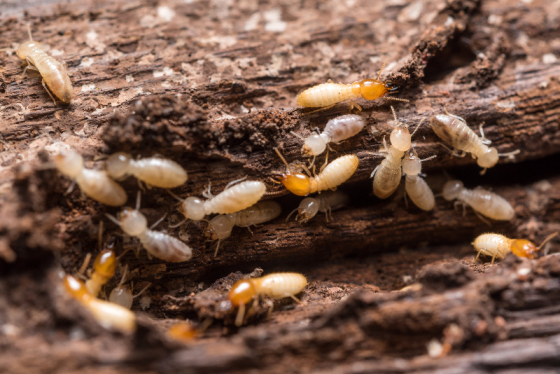WOOD-DESTROYING INSECTS
Wood-boring beetles. These types of beetles are primarily found in soft woods, such as girders, beams, foundation timbers, certain types of furniture, and even books. Some species also bore holes into plaster, plastic, and soft metals. Wood-boring beetle eggs and larvae are often difficult to spot, so wood should be carefully examined and kiln-dried prior to being used for lumber. Most species only attack living wood and cannot cause any further damage to seasoned wood. They do, however, leave small exit holes when emerging from the wood, which can cause structural damage. Keeping the humidity levels in your home low greatly reduces the likelihood of an infestation, as wood-boring beetles thrive in moist environments
Horntails. Commonly referred to as wood wasps, horntails can chew through virtually any household surface material: wallboard and plaster walls, sheet rock, hardwood floors, carpeting, linoleum, and non-ceramic floor tiles. Thankfully, though, wood wasp damage in buildings is usually more cosmetic than structural since they will not infest or re-infest treated wood. For that reason, it is important to only use properly treated wood for lumber and to store firewood outside of the home.
Carpenter ants. Carpenter ants are among the largest ants in the United States. They bore into wood to make their nests, especially in hollow doors, cracks and crevices, furniture, wall voids, and termite galleries. This has the potential to cause serious structural damage to a home. Carpenter ants prefer damp or decaying wood, so it is essential to repair any water damage in your home as soon as possible. Properly seal openings around utility pipes and wires to remove common entry points. Infestation can also occur when nearby land-clearing or construction disturbs existing native colonies.
WHAT ARE TERMITES?
Termites are one of the most common and destructive wood-destroying insects in the United States. They are a close relative of the cockroach that feed on completely or partially dead plants and trees. While termites play a vital role in the ecosystem, they become a major problem when they consume structural lumber. Termites build tunnels and burrow into wooden structures to obtain food. They will eat any wood or cellulose-containing material until only a shell remains. In addition, termites also attack stored food, furniture, and books.
Can TERMITES HARM HUMANS?
Termite colonies have highly-strategic soldiers who are equipped to defend and combat invading insects, such as ants and members of rival colonies. While termite populations cause severe harm to homes and are territorial with other insects, they are not known to attack humans. Avoid directly handling them as their natural instinct is to protect themselves. In general, though, homeowners experiencing an infestation need not be concerned about receiving bites from termites.
HOW DO I KNOW IF TERMITES HAVE INFESTED MY HOME?
Several warning signs can indicate that you may have a termite infestation:
- Termite exit holes. A termite exit hole will be round, one-eighth inch or smaller and filled with a brown, plaster-like substance.
- Winged, swarming termites present around windows and doors
- Cracked or bubbling paint (a result of termite droppings)
- Mud tubes on exterior walls, wooden beams, or in crawl spaces
- Sagging floors or ceilings
- Damaged wood (especially near the foundation of your home)
HOW DO I GET RID OF TERMITES?
Termites cause over $1 billion in damage to U.S. homes each year. Successful termite management requires special skills, including a working knowledge of building construction and an understanding of termite biology and identification. After fully assessing your situation, a Keystone inspector will refer you to a professional pest control company. They will determine the most effective ways to rid your home of the termite colony and recommend suggestions to prevent re-infestation.
Contact Us
* - Required Field
Keystone Home Inspection is proud to be a home inspector in the Greater Cleveland, Ohio area including Cuyahoga County, Geauga County, Lake County, Lorain County, Medina County, Portage County, and Summit County.
All Rights Reserved 2025, Keystone Home Inspection - Admin Login | Privacy Policy | Digital Marketing & Social Media Marketing by Alt Media Studios







